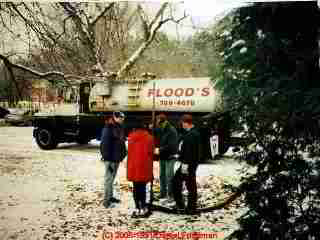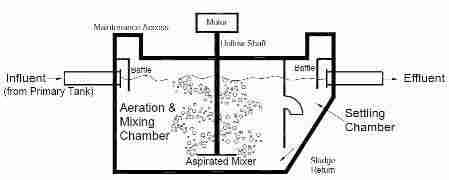 Maximize Septic System Life
Maximize Septic System Life
Septic System Maintenance Advice - Ten Steps in Septic System Care
- POST a QUESTION or COMMENT about septic tank care & septic drainfield care
Septic system life extension:
What steps can maximize the life of a septic tank & drainfield sysem?
How to take care of your septic system - latest septic system maintenance advice for homeowners to get the maximum septic tank life, maximum drainfield life, minimum septic system operating, maintenance, and replacement costs.
With rising septic repair prices and changing weather patterns due at least in part to global warming, septic maintenance is even more critical to keep a healthy home and yard and to avoid costly septic system repairs. Here is our updated septic system maintenance advice in a nutshell.
InspectAPedia tolerates no conflicts of interest. We have no relationship with advertisers, products, or services discussed at this website.
- Daniel Friedman, Publisher/Editor/Author - See WHO ARE WE?
Ten Simple Steps to Septic System Maintenance
 Septic drainfield failures or sewage backups may be more common than some people realize.
Septic drainfield failures or sewage backups may be more common than some people realize.
This is An Expanded Version of The EPA Septic Care Guide.
As the EPS said in the original and brief article on septic system care, "if your septic tank failed, or you know someone whose did, you are not alone. As a homeowner, you are responsible for maintaining your septic system.
Proper septic system maintenance will help keep your system from failing and will help maintain your investment in your home. Failing septic systems can contaminate the ground water that you or your neighbors drink and can pollute nearby rivers, lakes and coastal waters." - [Original text, U.S. EPA, editing/additions by author]
People normally seem to forget about their septic tank and drainfield until there are odors, slow drains, sewage backups, or sewage coming up in the yard - signs of a septic system problem. You can greatly extend the life of a septic system by taking care of it.
The most basic step in septic system care is to have the tank pumped on schedule. That's far more important than any magic additives, septic helper, or septic chemicals which usually are of little use and sometimes are downright harmful.
Here are ten simple steps that the US EPA suggested in order to keep your septic system working, with additional comments added by an experienced septic system inspector.
Also see SEPTIC TANK PUMPING SCHEDULE
and
see WHAT CAN GO INTO TOILETS & DRAINS?. The original content of this page was produced by the U.S. EPA with edits and addition of references to more in-depth information resources about onsite waste disposal inspection, diagnosis, repair, maintenance by DJF.
 If septic systems are new to you, see HOME BUYERS GUIDE to SEPTIC SYSTEMS.
If septic systems are new to you, see HOME BUYERS GUIDE to SEPTIC SYSTEMS.
- Locate your septic tank and drainfield. Keep a drawing of these locations in your records.
See SEPTIC TANK, HOW TO FIND and
also see our video on how to find septic components:
SEPTIC DRAINFIELD LOCATION - Have your septic system inspected at least every three years. This is a somewhat arbitrary rule of thumb but it's better than never doing anything. [Home buyers should be sure to review
our HOME BUYERS GUIDE to SEPTIC SYSTEMS Inspection & Testing -- DF] - Pump your septic tank as needed. Actually, to get this right,
see SEPTIC TANK PUMPING SCHEDULE
and also to stay out of trouble
see SEPTIC TANK PUMPING MISTAKES. - Don't dispose of household hazardous wastes in sinks or toilets.
See WHAT CAN GO INTO TOILETS & DRAINS?
And for the "Don'ts of septic systems"
see NEVER FLUSH INTO SEPTICS, BETTER NOT TO FLUSH,
and CHEMICALS & CLEANERS into the SEPTIC TANK? articles to learn what to keep out of your septic tank to prolong its life. - Keep other household items, such as dental floss [trivial in volume, but can clog or snag septic pumps, float switches, controls, feminine hygiene products, condoms, diapers, and cat litter out of your system.
See SEPTIC TANK & SYSTEM CARE BASICS - Use water efficiently. [Reducing water usage reduces the load on your drainfield -- DF] See our articles
GREYWATER SYSTEMS
and
ALTERNATIVE & WATERLESS TOILETS. Reduce water usage, install a drywell or graywater system. - Plant only grass over and near your septic system. Roots from nearby trees or shrubs might clog and damage the system. Also, do not apply manure or fertilizers over the drainfield. [See our
article, PLANTS & TREES OVER SEPTIC SYSTEMS for more details --DF] - Keep vehicles and livestock off your septic system. The weight can damage the pipes and tank, and your system may not drain properly under compacted soil.
See SEPTIC FIELD FAILURE CAUSES - Keep roof gutters and basement sump pumps from draining into or near your septic system. [And very important, keep surface runoff and subsurface runoff away from the septic tank and drainfield -- DF]
- Check with your local health department before using additives. Commercial septic tank additives do not eliminate the need for periodic pumping and can be harmful to your system.
[Actually most septic tank additives don't help, some septic tank additives are highly caustic or toxic and contaminate the environment, some hurt (like yeast), and some or perhaps all (depending on where you live) are illegal to apply -
see SEPTIC TREATMENTS & CHEMICALS septic tank chemicals, treatments, additives, reported as intended for extending the septic system life, "Un-Clogging," or "Repair" - Septic Tank Treatment -- DF]
And we add a compund eleventh septic system life extending step: - Improve the septic system: adding a greywater system, separate drywell, adding a septic tank inlet or outlet filter, or adding an aerator to convert the conventional septic tank to an aerobic design will increase the level of effluent treatment and extend drainfield life.
See details at SEPTIC FILTERS
See other options at SEPTIC SYSTEM DESIGN ALTERNATIVES
Watch out: adding a septic tank aerator with incomplete design can push solids into and destroy the drainfield.
Aerobic septic tanks use multiple chambers to avoid this problem; a retrofit design would typically include an outlet tee filter or separate filtering chamber that, if omitted or not properly maintained is likely to lead to sewage backups or septic system failure.
The U.S. EPA does not regulate septic systems, however, state and local governments do regulate the use of these systems.
Just about any question you could ask about residential septic system care, septic system maintenance, installation, design basics, tank pumping, field installation, and repair, is at
Owners and occupants of homes with septic systems and people who inspect or service septic systems should also
review SEPTIC SYSTEM SAFETY --DJF]
Useful Homeowners Guides to Septic Systems
U.S. EPA, A HOMEOWNERS' GUIDE to SEPTIC SYSTEMS [PDF] Ohio's re-publication of US EPA'S SEPTICSMART ADVICE, Website: www.epa.gov/septicsmart
Question: low-use septic tank pumping & freeze protection in Northern Ontario
(Oct 9, 2014) Keith said:
My tank is seasonal and this year had very little use. Do I need to have it pumped before winter. It is in northern Ontario.
Reply:
Keith
Usually septic tanks are left full all the time.
We pump a septic tank based on the tank size and amount of usage in wastewater flow.
Those details are
at SEPTIC TANK PUMPING SCHEDULE
When a septic system is not in use in freezing weather, it's likely that components that are not below the frost line will freeze.
If the tank is plastic or fiberglass or if it's below the frost line you should be ok.
Even if it's higher I'm not sure I'd empty it as frost around the tank exterior could still be a worry.
After all that thinking aloud I'd say I don't know. I would ask my local septic contractors to take a look at the type of tank you have, its location, its condition, and then to offer an opinion. Let me know what they think as what you learn will help others.
...
Continue reading at SEPTIC FIELD FAILURE CAUSES or select a topic from the closely-related articles below, or see the complete ARTICLE INDEX.
Or see these
Septic System Life Articles
- SEPTIC TANK & SYSTEM CARE BASICS
- SEPTIC DRAINFIELD LIFE
- SEPTIC LIFE EXPECTANCY
- SEPTIC LIFE MAXIMIZING STEPS
- SEPTIC TANK PUMPING SCHEDULE
- SEPTIC TREATMENTS & CHEMICALS
Suggested citation for this web page
SEPTIC LIFE MAXIMIZING STEPS at InspectApedia.com - online encyclopedia of building & environmental inspection, testing, diagnosis, repair, & problem prevention advice.
Or see this
INDEX to RELATED ARTICLES: ARTICLE INDEX to SEPTIC SYSTEMS
Or use the SEARCH BOX found below to Ask a Question or Search InspectApedia
Ask a Question or Search InspectApedia
Questions & answers or comments about how to maximize septic systerm life..
Try the search box just below, or if you prefer, post a question or comment in the Comments box below and we will respond promptly.
Search the InspectApedia website
Note: appearance of your Comment below may be delayed: if your comment contains an image, photograph, web link, or text that looks to the software as if it might be a web link, your posting will appear after it has been approved by a moderator. Apologies for the delay.
Only one image can be added per comment but you can post as many comments, and therefore images, as you like.
You will not receive a notification when a response to your question has been posted.
Please bookmark this page to make it easy for you to check back for our response.
IF above you see "Comment Form is loading comments..." then COMMENT BOX - countable.ca / bawkbox.com IS NOT WORKING.
In any case you are welcome to send an email directly to us at InspectApedia.com at editor@inspectApedia.com
We'll reply to you directly. Please help us help you by noting, in your email, the URL of the InspectApedia page where you wanted to comment.
Citations & References
In addition to any citations in the article above, a full list is available on request.
- New York State Department of Health, APPENDIX 75-A WASTEWATER TREATMENT STANDARDS - INDIVIDUAL HOUSEHOLD SYSTEMS , [PDF] New York State Department of Health, 3 February 2010, retrieved 3/1/2010, original source: https://www.health.ny.gov/regulations/nycrr/title_10/part_75/appendix_75-a.htm
- Our recommended books about building & mechanical systems design, inspection, problem diagnosis, and repair, and about indoor environment and IAQ testing, diagnosis, and cleanup are at the InspectAPedia Bookstore. Also see our Book Reviews - InspectAPedia.
- In addition to citations & references found in this article, see the research citations given at the end of the related articles found at our suggested
CONTINUE READING or RECOMMENDED ARTICLES.
- Carson, Dunlop & Associates Ltd., 120 Carlton Street Suite 407, Toronto ON M5A 4K2. Tel: (416) 964-9415 1-800-268-7070 Email: info@carsondunlop.com. Alan Carson is a past president of ASHI, the American Society of Home Inspectors.
Thanks to Alan Carson and Bob Dunlop, for permission for InspectAPedia to use text excerpts from The HOME REFERENCE BOOK - the Encyclopedia of Homes and to use illustrations from The ILLUSTRATED HOME .
Carson Dunlop Associates provides extensive home inspection education and report writing material. In gratitude we provide links to tsome Carson Dunlop Associates products and services.

